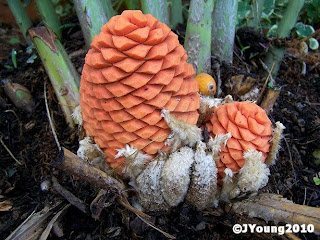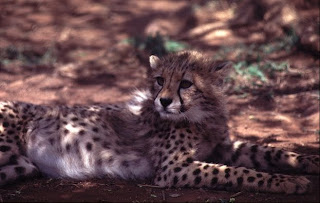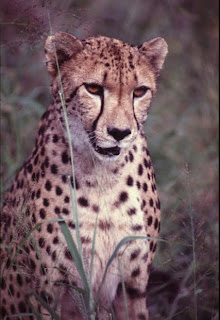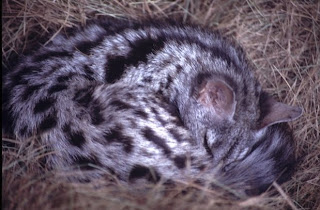 The pods of this particular species are low on the ground and surrounded by leaves.
The pods of this particular species are low on the ground and surrounded by leaves. It gets to be a tall pod and at the bottom of each seed are what look like spores. Maybe someone knows and can tell me what they actually are.
It gets to be a tall pod and at the bottom of each seed are what look like spores. Maybe someone knows and can tell me what they actually are. The pods of this particular species are low on the ground and surrounded by leaves.
The pods of this particular species are low on the ground and surrounded by leaves. It gets to be a tall pod and at the bottom of each seed are what look like spores. Maybe someone knows and can tell me what they actually are.
It gets to be a tall pod and at the bottom of each seed are what look like spores. Maybe someone knows and can tell me what they actually are.

Their name is derived from and Indian word “chita” which means “spotted one.” The tail of these beautiful creatures is moved from right to left like rudders to facilitate their changing direction when in high speed pursuit of an intended victim.
The tail of these beautiful creatures is moved from right to left like rudders to facilitate their changing direction when in high speed pursuit of an intended victim. 
An open environment is preferred by them, for, by lying on top of a raises raised piece of ground or anthill, they are able to spot their prey quite a distance away. Cheetahs are easily distinguished. Even at a distance, the muscular shoulders sloping down to their hind quarters, stream-lined belly and small head can be seen.
Cheetahs are easily distinguished. Even at a distance, the muscular shoulders sloping down to their hind quarters, stream-lined belly and small head can be seen. Females will breed only after the current litter reaches the age of about two years. They are found in small family groups of two to five.
Females will breed only after the current litter reaches the age of about two years. They are found in small family groups of two to five.
Impala and other medium sized antelope make up most of their diet, but they also eat hares, guinea fowl, ostrich, warthog and any other game which might be available. 
Males will urinate on the boundaries of their territory and, as this smell lasts for about twenty four hours, they will need to do this fairly regularly to ensure that other cheetah males do not come into their area.
 Mostly they eat insects which they dig for or find by looking under stones, but their diet includes worms, larvae, mice and small snakes.
Mostly they eat insects which they dig for or find by looking under stones, but their diet includes worms, larvae, mice and small snakes.  Many people do not know that giraffes can sit down like this.
Many people do not know that giraffes can sit down like this. They have the second longest gestation period, 15 months after which a single calf is born.
They have the second longest gestation period, 15 months after which a single calf is born.
 There are 7 bones in their necks. The same as humans and sparrows.
There are 7 bones in their necks. The same as humans and sparrows. Giraffe, Blue Wildebeest, Impala and Zebra are mostly found in mixed herds. Each species eats a different kind of food so are not competition for one another.
Giraffe, Blue Wildebeest, Impala and Zebra are mostly found in mixed herds. Each species eats a different kind of food so are not competition for one another. The pigmentation of their skin is the same as our, some have lighter skins than others.
The pigmentation of their skin is the same as our, some have lighter skins than others. 
 Ostriches have great vision and because of their strong legs can run at 70 km (40 miles) per hour.
Ostriches have great vision and because of their strong legs can run at 70 km (40 miles) per hour. Territorial males compete for flocks of 3 to 5 hens. Mating includes elaborate displays of hisses and dancing. Once divided into mating groups, ostriches in some areas use communal nests to hold anywhere from 14 to 60 eggs. The nest is a hole scraped in bare ground about 1 to 2 feet deep. The average egg is 6 inches in length, 5 inches in width, weighs about 3 pounds, and is shiny and whitish in color. Eggs take approximately 35 - 40 days to hatch. The male, which has mostly black feathers, sits on the eggs at night, and the drab, brown female who lays up to 20 eggs, covers them during the day. Only 15 percent of chicks make it to their first birthday, despite having protection from their parents.
Territorial males compete for flocks of 3 to 5 hens. Mating includes elaborate displays of hisses and dancing. Once divided into mating groups, ostriches in some areas use communal nests to hold anywhere from 14 to 60 eggs. The nest is a hole scraped in bare ground about 1 to 2 feet deep. The average egg is 6 inches in length, 5 inches in width, weighs about 3 pounds, and is shiny and whitish in color. Eggs take approximately 35 - 40 days to hatch. The male, which has mostly black feathers, sits on the eggs at night, and the drab, brown female who lays up to 20 eggs, covers them during the day. Only 15 percent of chicks make it to their first birthday, despite having protection from their parents. Ostriches were almost wiped out in the 18th century due to hunting for feathers. By the middle of the 19th century, due to the extensive practice of ostrich farming the ostrich population increased. The movement changed to domesticating and plucking ostriches, instead of hunting. Ostriches have been successfully domesticated and are now farmed throughout the world, particularly in South Africa, for meat, feathers and leather. The leather goes through a tanning process and is then manufactured into fashion accessories such as boots and bags.
Ostriches were almost wiped out in the 18th century due to hunting for feathers. By the middle of the 19th century, due to the extensive practice of ostrich farming the ostrich population increased. The movement changed to domesticating and plucking ostriches, instead of hunting. Ostriches have been successfully domesticated and are now farmed throughout the world, particularly in South Africa, for meat, feathers and leather. The leather goes through a tanning process and is then manufactured into fashion accessories such as boots and bags.